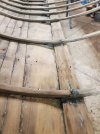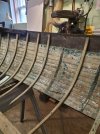Makeryguy
Old Soul
Firstly, It is great to be back on the forums. I was active 20 years ago when I built my first stripper. I've attended many of the assemblies at Paul Smith's and had the pleasure of meeting Ted Moore, and he signed my copy of Canoecraft. I wasn't able to make it this year, but was happy to see that it was indeed at Paul Smith's with that location being in question. I hope you are all well and happy.
As of this morning, I have this canoe in my shop. An intern of mine from a few years back has taken on the project, and as he is away on summer cruise at SUNY Maritime, asked if I could help him get a jump on the restoration while he's at sea.
I've included pictures. My first item of business has been doing an inventory of what he has disassembled. I've clamped the decks, outwales and outer stem together for pictures, There are no inner or outer stems in the other end of the canoe. The way the keel, inner and outer stems connect may help with identification.
Another unique construction method to note is that the strips are nailed down into one another vertically, as well as nailed to the ribs. I've never seen this before.
If I can establish a model, that will help me set parameters for shoring up this craft to build back the structure to its original width, and depth etc. The main keel is broken in the center as well. I do have a current length measurement of 15', width of 36" and approximate hull depth of 16" at center.
I look forward to hearing everyone's thoughts on who the manufacturer may be, and perhaps an approximate age.
Thank you so much!
As of this morning, I have this canoe in my shop. An intern of mine from a few years back has taken on the project, and as he is away on summer cruise at SUNY Maritime, asked if I could help him get a jump on the restoration while he's at sea.
I've included pictures. My first item of business has been doing an inventory of what he has disassembled. I've clamped the decks, outwales and outer stem together for pictures, There are no inner or outer stems in the other end of the canoe. The way the keel, inner and outer stems connect may help with identification.
Another unique construction method to note is that the strips are nailed down into one another vertically, as well as nailed to the ribs. I've never seen this before.
If I can establish a model, that will help me set parameters for shoring up this craft to build back the structure to its original width, and depth etc. The main keel is broken in the center as well. I do have a current length measurement of 15', width of 36" and approximate hull depth of 16" at center.
I look forward to hearing everyone's thoughts on who the manufacturer may be, and perhaps an approximate age.
Thank you so much!
Attachments
-
 20230717_140005.jpg272 KB · Views: 205
20230717_140005.jpg272 KB · Views: 205 -
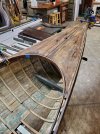 20230717_140025.jpg282.2 KB · Views: 193
20230717_140025.jpg282.2 KB · Views: 193 -
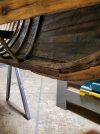 20230717_140042.jpg151.8 KB · Views: 212
20230717_140042.jpg151.8 KB · Views: 212 -
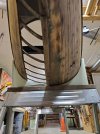 20230717_140115.jpg186.4 KB · Views: 183
20230717_140115.jpg186.4 KB · Views: 183 -
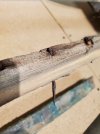 20230717_140234.jpg110.5 KB · Views: 184
20230717_140234.jpg110.5 KB · Views: 184 -
 20230717_140239.jpg158.2 KB · Views: 181
20230717_140239.jpg158.2 KB · Views: 181 -
 20230717_140254.jpg204.2 KB · Views: 178
20230717_140254.jpg204.2 KB · Views: 178 -
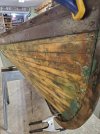 20230717_140304.jpg183.9 KB · Views: 191
20230717_140304.jpg183.9 KB · Views: 191 -
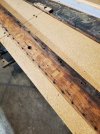 20230717_140325.jpg261.5 KB · Views: 193
20230717_140325.jpg261.5 KB · Views: 193

